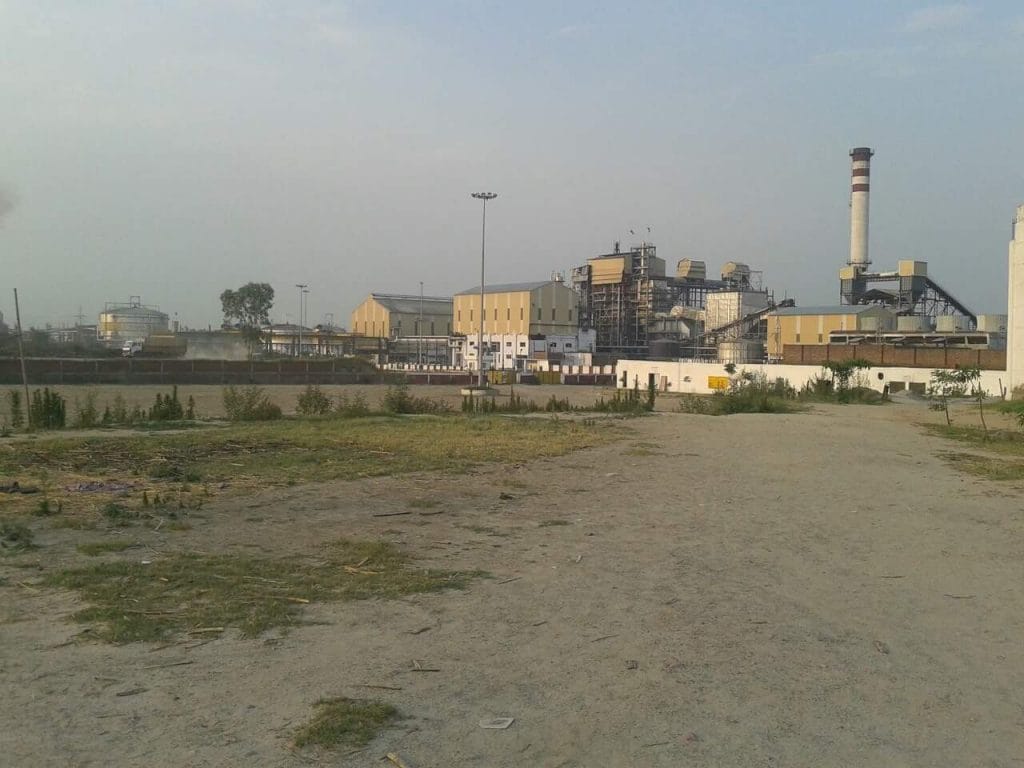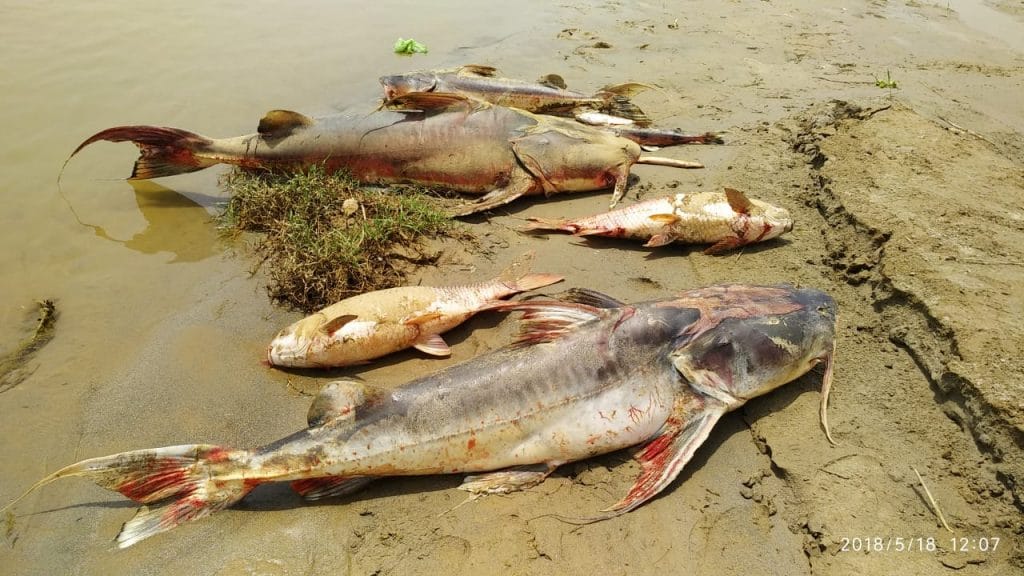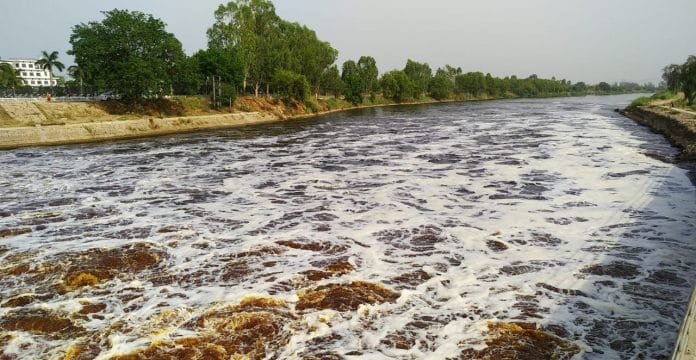A massive spillage of an estimated 10,000 litres of molasses from a sugar mill in Gurdaspur district into the river Beas Wednesday might have been government doing.
Chandigarh: The Punjab government is worried as the state stares at its worst ecological disaster in recent years which may have been the result of its own order looking to make use of the sugarcane glut.
A massive spillage of estimated 10,000 litres of molasses from a sugar mill in Gurdaspur district into the river Beas last Wednesday, that has already killed tonnes of aquatic life in its wake, has made its impact right up to Rajasthan through the irrigation canal system. The state authorities are starting to test the waters entering their territory for potability, while rationing their stored drinking water supply as well.
A team of the union environment ministry has been deputed to assess the damage and fix responsibility. The first set of samples of the raw water from the river failed Monday while the test results of the drinking water have been found to be in the “unhealthy range” raising fears that contaminated water might have already made its way into the drinking water reservoirs.
‘It was an accident’
While governor V.P.S. Badnore has sought a report from the chief minister’s office Monday, Punjab Pollution Control Board (PPCB) chairman Kahan Singh Pannu indicates a probable government role, apart from the possible negligence on part of the management of the Chadha Sugar Mill from where the spillage happened.

“Molasses is a byproduct obtained while crushing sugarcane. Sugar mills have a certain capacity to store molasses in specialised tanks. However, this season the government ordered several sugar mills across Punjab (including Chadha Sugar Mill) to continue sugarcane crushing till 30 April as there was a glut of sugarcane,” said Pannu.
“Since milling continued for an additional month, mills built underground tanks to store excess molasses. At the Chadha mill, an exothermic reaction took place inside the underground tank and stored molasses shot up into the air, almost like lava from a volcano. The blast damaged the boundary wall and the steaming molasses started flowing into a drain next to the mill which emptied into the Beas, barely a kilometer away. By Thursday, we estimate, almost 10,000 litres of molasses had flowed into the river,” said Pannu.
Rakesh Sharma, the cane manager at the Chadha Sugar Mill, said they were forced to crush sugarcane beyond the provided capacity.
“We crushed 1.2 crore quintal sugarcane in this season. We did not want to go beyond 21 April but we continued till 30 April because of government’s pressure. We have proof to show that the deputy commissioner Gurdaspur asked us to crush additional sugarcane. We made arrangements to store excess molasses. What happened was a result of a natural reaction in the storage area,” he said adding that molasses lost were worth Rs 8-9 crore. “Molasses are an expensive raw material for other industries. Why would we spill it into water?” he said.
Delayed action
As the molasses, a thick viscose black fluid, flowed into the river it turned the water black and killed marine life almost instantly. Dead bodies of fish of various sizes were seen floating or gathering on the banks across almost the entire length of the river down from the site of the spill. The river is home to the Indus River Dolphin, one of the world’s rarest mammals, and gharials, both of which have survived the spillage but the prey zone has shrunk considerably.
The discoloured water was first noticed downstream of the spill site on Thursday afternoon where villagers contacted forest officials of Beas town who lodged a police complaint against unidentified persons for causing damage to wildlife. The police refused to investigate saying the matter was ‘outside their jurisdiction’.

The next day, however, the state machinery sprung into action. Almost 2000 cusecs of water was pumped into the river from the Ranjit Sagar Dam to flush out the molasses. Environment minister O.P. Soni ordered the sealing of the mill as also forfeiting of their security deposit of Rs 25 lakh. However no criminal proceedings were initiated against the mill owners/management.
The minister constituted a probe committee to report if the leakage was caused due to negligence or was an accident. The report was submitted in a sealed cover Tuesday. “I have yet to see the report as I am traveling. Further action, if any, against the mill’s management/owners will be taken only after looking at the findings of the probe committee,” said Pannu.
The opposition Shiromani Akali Dal (SAD) slammed the government for ‘patronising an environmental massacre’ in the state to “protect the mill owners who are close to chief minister Captain Amarinder Singh.” SAD president Sukhbir Badal asked the Centre to intervene.
It was negligence: locals
Locals living in affected villages protested at several places squarely blaming the mill for ‘poisoning’ the river due to negligence. “The mill owners crushed much more sugarcane than the limit prescribed to them and large amounts of molasses were stored dangerously. Once the spillage started, the management refused to do anything to stop it till villagers gathered outside the mill in protest. After that, the mill management brought a JCB and stopped the spillage which they could’ve done earlier,” said a resident of village Kiri Afghana in Gurdaspur district where the mill is located.
Others pointed out that the PPCB had now sealed the sugar mill which was an “eye-wash” as the mill stopped milling work 20 days ago. “The alcohol factories owned by the same persons who own the mill are running next to it. These have not been shut down,” said another resident.
Who owns the mill?
According to the records of the registrar of companies, the sugar mill is owned by, among others, Jasdeep Kaur Chadha, a prominent liquor contractor of Punjab. She is the widow of Hardeep Singh Chadha, who along with his elder brother, liquor and realty baron Ponty Chadha, had died in cross-firing over a property dispute in New Delhi in 2012.
After her husband’s death, Jasdeep took over the liquor business running it rather successfully. She is the daughter of former Delhi Sikh Gurdwara Management Committee president Harwinder Sarna. Sarna and his brother Paramjit Sarna are said to have close ties with Captain Amarinder Singh. Apart from the sugar mill, the same set of owners is running brewery and distillery units in the campus in the village.
Polluted water enters canal system
Having run downstream from the spill site, the sullied water entered the irrigation canal system at the Harike barrage in Ferozepur district. This barrage is constructed at the confluence of rivers Beas and Sutlej. The blackened water entered four canals here: Rajasthan feeder, Sirhind Canal, Gang Canal and the Eastern Canal. Two of these carry Beas water to Sri Ganganagar, Bikaner and up to Jaisalmer in Rajasthan.
Since there is no way to stop the water from running into canals and further to its distributaries, the minors and sub-minors, quality of the irrigation water to districts Faridkot, Muktsar and Fazilka was severely affected. Farmers were in for a shock as highly polluted water, carrying with it dead fish emanating stench entered their fields Saturday.
The pollution control board, however, said that the sullied water will not damage crops. “We believe that since the pollutant is organic in nature, it will not cause any harm to the crops,” said Pannu.
Drinking water
Once in the canals, the water was taken into the drinking water systems set up by the department of water supply and sanitation on these canals. The canal drinking water systems supplement the supply of drinking water from tubewells and hand pumps in the area. River water is taken in from the irrigation canals, treated, purified and stored for supply to residents mainly in rural areas and small towns.
“We shut down the intake from the canals carrying Beas water on Saturday at 6 AM. We are monitoring and sampling the quality of the water. Over 30 samples have been taken from the river as also of the treated and purified water for testing. Some of the reports of the treated water have come in. The Chemical Oxygen Demand (COD) tests have revealed that it is around 8 to 11, a little higher than permissible limits but this could have been the case before the river was polluted,” said Jaspreet Talwar, secretary, water supply and sanitation.
“The biochemical oxygen demand (BOD) test results are yet to come in. We have advised residents in the affected districts (Abohar, Ferozepur, Fazilka, Faridkot and Muktsar) to drink water only from the reverse osmosis systems installed in the area. We are also taking samples of underground water pulled in through hand pumps,” she said.
With only a week-long worth of stored water, drinking water supply to affected towns has been rationed or severely curtailed.
Environmentalist Balbir Singh Seechewal said apart from molasses, the water was now full of dead fish and cannot be used for drinking.
Aquatic life
The most visible impact of the pollution has been on fresh water marine life in the river. Several species of fish which fall in the ‘nearly threatened’ or ‘vulnerable’ categories have been killed. These include the dwarf river monster, malhi, chitala and the common snow trout. Others like the giant river cat fish have also been killed in large numbers.
“From what we understand, the molasses on entering the water caused an immediate depletion of dissolved oxygen suffocating those fish to death which live on dissolved oxygen. The gharials have survived, probably having moved to the banks or sand islands inside the river,” said Kuldip Kumar, chief wildlife warden, Punjab who visited the river with his team to assess the damage.
The Indus River Dolphins could not be sighted for some days after the event causing concern. However, a group of three was sighted Monday.
Following the procedure under the Wildlife Act, the department has moved a complaint in a local court against the mill for causing large scale mortality of fish and prey base. Pannu said that initially locals transported the dead fish for consumption, and have been advised not to do so as that might be poisonous/infected.
The potential damage caused to the Harike Wetland and Bird Sanctuary is yet to be assessed.






